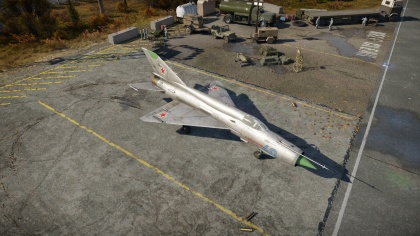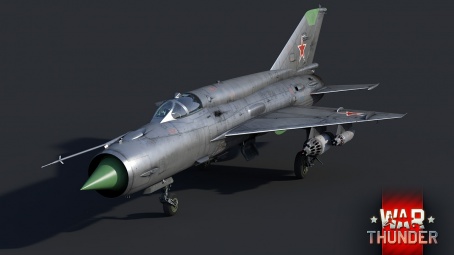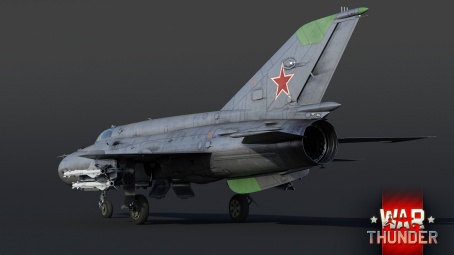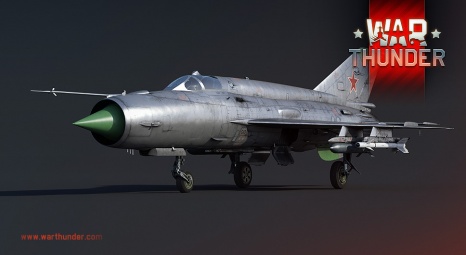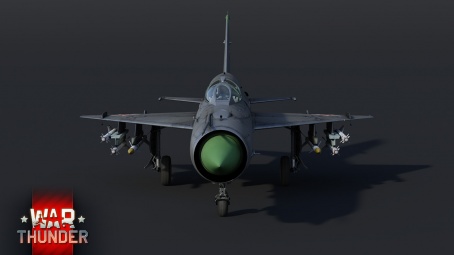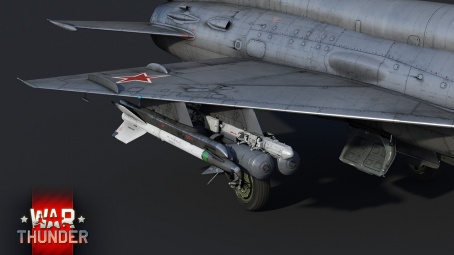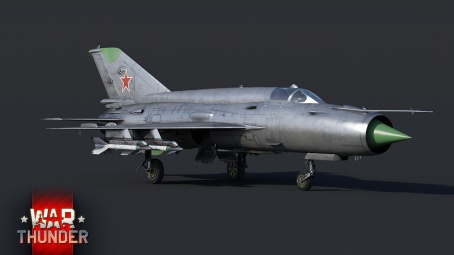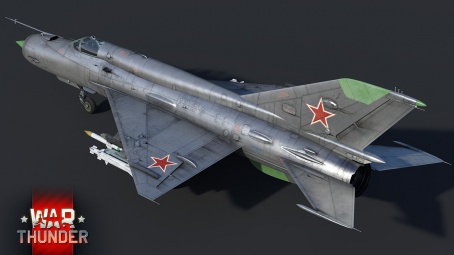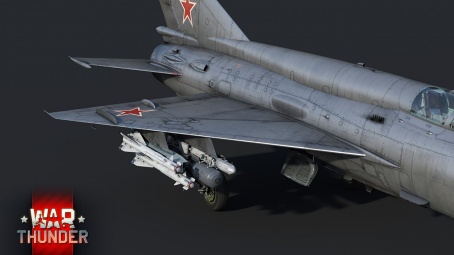Difference between revisions of "MiG-21bis"
Colok76286 (talk | contribs) (→Media: Reworked structure) |
TheElite96 (talk | contribs) (→Flight performance) (Tag: Visual edit) |
||
| Line 23: | Line 23: | ||
|- | |- | ||
! Stock | ! Stock | ||
| − | | 2,177 || 2,141 || rowspan="2" | {{Specs|ceiling}} || 37.7 || 38. | + | | 2,177 || 2,141 || rowspan="2" | {{Specs|ceiling}} || 37.7 || 38.5 || 191.4 || 179.8 || rowspan="2" | 750 |
|- | |- | ||
! Upgraded | ! Upgraded | ||
| − | | | + | |2305|| 2240 ||36.4||37.0||262.7||225.0 |
|- | |- | ||
|} | |} | ||
| Line 251: | Line 251: | ||
== Media == | == Media == | ||
<!-- ''Excellent additions to the article would be video guides, screenshots from the game, and photos.'' --> | <!-- ''Excellent additions to the article would be video guides, screenshots from the game, and photos.'' --> | ||
| + | |||
;Skins | ;Skins | ||
Revision as of 22:09, 23 December 2020
Contents
Description
The MiG-21bis is a rank VII Soviet jet fighter
with a battle rating of 11.0 (AB) and 11.3 (RB/SB). It was introduced in Update "New Power".
General info
Flight performance
Describe how the aircraft behaves in the air. Speed, manoeuvrability, acceleration and allowable loads - these are the most important characteristics of the vehicle.
| Characteristics | Max Speed (km/h at 13,000 m) |
Max altitude (metres) |
Turn time (seconds) |
Rate of climb (metres/second) |
Take-off run (metres) | |||
|---|---|---|---|---|---|---|---|---|
| AB | RB | AB | RB | AB | RB | |||
| Stock | 2,177 | 2,141 | 16000 | 37.7 | 38.5 | 191.4 | 179.8 | 750 |
| Upgraded | 2305 | 2240 | 36.4 | 37.0 | 262.7 | 225.0 | ||
Details
| Features | |||||
|---|---|---|---|---|---|
| Combat flaps | Take-off flaps | Landing flaps | Air brakes | Arrestor gear | Drogue chute |
| X | ✓ | ✓ | ✓ | X | ✓ |
| Limits | ||||||
|---|---|---|---|---|---|---|
| Wings (km/h) | Gear (km/h) | Flaps (km/h) | Max Static G | |||
| Combat | Take-off | Landing | + | - | ||
| 1365 | 700 | N/A | 550 | 450 | ~11 | ~6 |
| Optimal velocities (km/h) | |||
|---|---|---|---|
| Ailerons | Rudder | Elevators | Radiator |
| < 650 | < 600 | < 900 | N/A |
Engine performance
| Engine | Aircraft mass | ||||||
|---|---|---|---|---|---|---|---|
| Engine name | Number | Basic Mass | Wing loading (full fuel) | ||||
| Tumansky R-25-300 | 1 | 6,082 kg | 369 kg/m2 | ||||
| Engine characteristics | Mass with fuel (no weapons load) | Max Takeoff Weight | |||||
| Weight (each) | Type | 10m fuel | 20m fuel | 30m fuel | 36m fuel | ||
| 1,040 kg | Afterburning axial-flow turbojet | 6,749 kg | 7,415 kg | 8,082 kg | 8,482 kg | 10,000 kg | |
| Maximum engine thrust @ 0 m (RB / SB) | Thrust to weight ratio @ 0 m (WEP) | ||||||
| Condition | 100% | WEP | 10m fuel | 20m fuel | 30m fuel | 36m fuel | MTOW |
| Stationary | 4,040 kgf | 7,224 kgf | 1.07 | 0.97 | 0.89 | 0.85 | 0.72 |
| Optimal | 4,202 kgf (1,400 km/h) |
9,312 kgf (1,400 km/h) |
1.38 | 1.26 | 1.15 | 1.10 | 0.93 |
Survivability and armour
- 60 mm bulletproof glass - armoured windscreen
- 10 mm steel - bulkhead behind pilot
- Engine and fuel tanks take up most of the fuselage area behind the cockpit
Armaments
Offensive armament
The MiG-21bis is armed with:
- 1 x 23 mm GSh-23L cannon, belly-mounted (250 rpg)
Suspended armament
The MiG-21bis can be outfitted with the following ordnance:
- Without load
- 64 x S-5K rockets
- 96 x S-5K rockets
- 4 x S-24 rockets
- 4 x R-3S missiles
- 4 x R-13M missiles
- 4 x R-3R missiles
- 2 x R-3R missiles + 2 x R-3S missiles
- 2 x R-3R missiles + 2 x R-13M missiles
- 4 x R-60 missiles
- 2 x R-3S missiles + 4 x R-60 missiles
- 2 x R-3S missiles + 64 x S-5K rockets
- 2 x R-13M missiles + 64 x S-5K rockets
- 2 x R-3R missiles + 64 x S-5K rockets
- 4 x R-60 missiles + 64 x S-5K rockets
- 2 x R-3S missiles + 2 x S-24 rockets
- 2 x R-13M missiles + 2 x S-24 rockets
- 2 x R-3R missiles + 2 x S-24 rockets
- 4 x R-60 missiles + 2 x S-24 rockets
- 2 x R-3S missiles + 8 x 100 kg OFAB-100 bombs (800 kg total)
- 2 x R-3R missiles + 8 x 100 kg OFAB-100 bombs (800 kg total)
- 2 x R-13M missiles + 8 x 100 kg OFAB-100 bombs (800 kg total)
- 2 x R-60 missiles + 4 x 100 kg OFAB-100 bombs (400 kg total)
- 8 x 100 kg OFAB-100 bombs (800 kg total)
- 2 x 500 kg FAB-500M-54 bombs (1,000 kg total)
- 2 x R-3S missiles + 2 x 250 kg FAB-250M-62 bombs (500 kg total)
- 2 x R-13M missiles + 2 x 250 kg FAB-250M-62 bombs (500 kg total)
- 2 x R-3R missiles + 2 x 250 kg FAB-250M-62 bombs (500 kg total)
- 4 x R-60 missiles + 4 x 100 kg OFAB-100 bombs (400 kg total)
- 4 x R-60 missiles + 2 x 250 kg FAB-250M-62 bombs (500 kg total)
- 2 x R-3R missiles + 4 x R-60 missiles
- 2 x R-13M missiles + 4 x R-60 missiles
- 6 x R-60 missiles
Usage in battles
This plane is fairly manoeuvrable at high speeds and since it accelerates very fast and climbs extremely well, it works well as an interceptor (you take off, reach around 1000 km/h, burstclimb at a 20-25 degree angle up to 6,000-7,000 metres and fire on anything you see in front of you) but this method has some risks.
First you're very prone to the Matra R530E and the infamous AIM-7 SARHMs (Semi Active Radar Homing Missiles) that can easily shoot you down since your plane becomes a brick at higher altitudes.
And sometimes, even if you achieve your interception objective, some enemies will fly in a different path, so they'll easily sneak up behind you and take you down if you're high or slow enough.
The 2nd way to play this plane is to fly at lower altitudes (below 2,000 m) and engage any target you may see, the risk here is that you're vulnerable to high-flying enemies that, again, can easily sneak up on you and take you down, so pay attention.
The 3rd way and probably the safest playstyle (recommended to stock players) is to "flank", or slightly sideclimb up to 4-5 km, wait until the majority of the enemy team is spotted and then come back to the battelfield and engage targets. It is safe because most (if not all) of your enemies, which are Phantoms and Mirages, will most likely play aggressively by climbing directly towards your team, so the only enemies you may encounter in your flank path are other stock players, AFK players, or, with a measure of unluckiness, cunning players that are aware of you. So pay attention when flanking and try to take the least frequented flight path (or the flyzone that is the farthest from the main battlefield or warzone).
Enemies you should pay attention to:
- Phantoms, particularly F-4E and EJ models: these should be your priority targets, F-4Es and F-4EJs are very well known for being extremely versatile and dangerous (even sometimes referred to as the best top tier jets in the game). These planes accelerate very well, can wield the dangerous AIM-9J AAMs that are able to pull 20 Gs of overload and very often can hit targets up to 3 km of range, have access to a very good amount of flares and have very responsive controls. However, a lot of Phantom pilots are very overconfident into their planes and will very often jump into a dogfight with you, as a MiG-21 which is a very bad idea for them. Everybody knows the motto "a slow jet is a dead jet" which is true but the MiG-21 has an ace up its sleeve against Phantoms: better low speed manoeuvrability and high speed manoeuvrability that can sometimes match the Phantom's turn rate! So if a Phantom attempts to dogfight you, go for it, they'll most likely lose, but only do so if your team is nearby or if there aren't any enemies nearby or you may end up getting taken out unexpectedly.
- The Mirage IIIC and the J35D Draken: These planes are also serious foes since they out turn everything at their BR (keep in mind that the J35D Draken is more manoeuvrable than the Mirage) so dogfighting them is a death sentence. They're also able to wield deadly missiles, the Draken wields the Swedish license built AIM-9Js known as RB24Js and the Mirage has access to the extremely effective Matra R550 Magic 1 that pulls 30 Gs and has a higher top speed than other IR guided missiles. The best thing to do against these planes is to do a zoom climb to bleed their speed since they have a lower thrust to weight ratio than you and then do oblique turns since they both bleed a ton of speed when turning and have a lower acceleration than you do. And if they try to fire a missile at you? Don't worry, pop flares, turn off afterburner, and pull hard.
Modules
| Tier | Flight performance | Survivability | Weaponry | |||
|---|---|---|---|---|---|---|
| I | Fuselage repair | Compressor | FAB-250 | FAB-500 | R-3S | |
| II | New boosters | Airframe | Flares | UB-16 | R-3R | |
| III | Wings repair | Offensive 23 mm | UB-32 | R-13M | ||
| IV | G-suit | Engine | Cover | New 23 mm cannons | C-24 | R-60 |
Pros and cons
Pros:
- Impressive climb rate of 225 m/s, making this plane the 2nd best top tier climber behind the F-104S and above the Phantom FGR.2 and FG.1
- Increased flight performance compared to earlier MiG-21s
- Very capable both against aerial and ground targets
- Has access to flares that are fired downwards, which means that missiles will be dodged easier
- Stunning acceleration
- Very good energy retention
- Can wield 6 R-60s
- Huge thrust to weight ratio
Cons:
- As all MiG-21s, it tends to bleed speed in turns, though not as much, thanks to the improved engine
- Vicious rudder lock at speeds above 700 km/h, can be frustrating when trying to get guns on target
- Pretty bad low speed manoeuvrability
- Doesn't respond well to wing damage - if a wingtip is lost, landing this plane will be very difficult, and if a wing is lost, the plane should be considered as lost
History
Devblog
By the late 1960’s, the Soviet high command sought to increase the effectiveness of the MiG-21 jet fighter, especially at lower altitudes, while at the same time knowing that this could only be achieved by developing a more powerful engine for it. As a result, in 1971, the order to develop what would essentially become the MiG-21bis was issued by the Soviet high command.
As both the power plant manufacturer - Tumansky - as well as the MiG aircraft design bureau were already working on improvements, this order only officially recognized their work, and as a result, by 1972 the MiG-21bis was ready.
Unlike preceding variants, the MiG-21bis managed to strike a balance between performance and endurance. Additionally, the aircraft was fitted with an improved radar and a systems monitor, which made maintenance substantially easier. Furthermore, the maximum number of missiles the aircraft could carry was increased to six while it also received the option to carry the new R-13M air-to-air missile with increased range over the preceding R-3S; and R-60 missiles as well.
The first MiG-21bis was constructed in 1972 and was adopted into service in the same year. Well over 2,200 units of the MiG-21bis would be manufactured, including licence-built versions. The MiG-21bis was one of the most widely produced variants of the aircraft and saw widespread use with numerous operators around the globe. In fact, some modernized modifications are still in combat use today.
Media
- Skins
- Images
- MiG-21bis Devblog Images
- Videos
See also
Links to the articles on the War Thunder Wiki that you think will be useful for the reader, for example:
- reference to the series of the aircraft;
- links to approximate analogues of other nations and research trees.
External links
| USSR jet aircraft | |
|---|---|
| Bereznyak-Isayev | BI |
| Yakovlev | Yak-15 · Yak-15P · Yak-17 · Yak-23 · Yak-28B · Yak-30D · Yak-38 · Yak-38M · Yak-141 |
| Mikoyan-Gurevich | MiG-9 · MiG-9 (l) · MiG-15 · MiG-15bis · MiG-15bis ISh · MiG-17 · MiG-17AS · MiG-19PT |
| MiG-21F-13 · MiG-21PFM · MiG-21S (R-13-300) · MiG-21SMT · MiG-21bis | |
| MiG-23M · MiG-23ML · MiG-23MLD · MiG-27M · MiG-27K | |
| MiG-29 · MiG-29SMT | |
| Lavochkin | La-174 · La-15 · La-200 |
| Sukhoi | Su-9 · Su-11 |
| Su-7B · Su-7BKL · Su-7BMK · Su-17M2 · Su-17M4 · Su-22M3 | |
| Su-24M | |
| Su-25 · Su-25BM · Su-25K · Su-25T · Su-25SM3 · Su-39 | |
| Su-27 · Su-27SM | |
| Ilyushin | IL-28 · IL-28Sh |
| Tupolev | Tu-14T |



